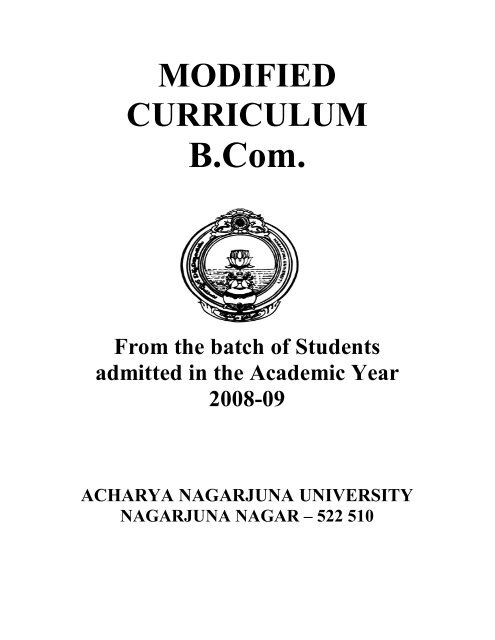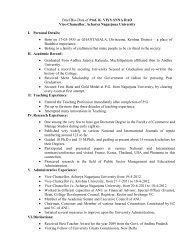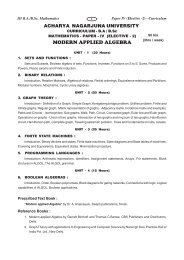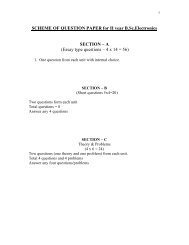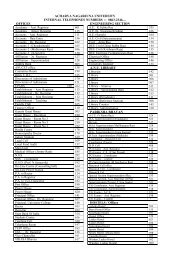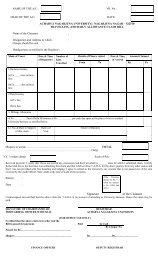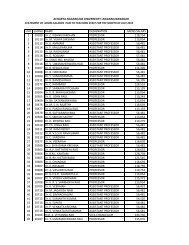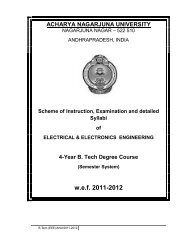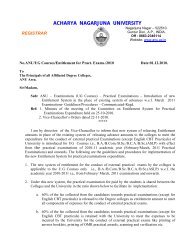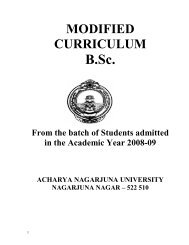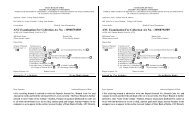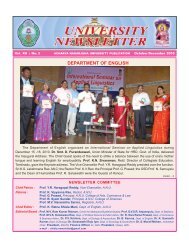B.Com. - Acharya Nagarjuna University
B.Com. - Acharya Nagarjuna University
B.Com. - Acharya Nagarjuna University
Create successful ePaper yourself
Turn your PDF publications into a flip-book with our unique Google optimized e-Paper software.
MODIFIEDCURRICULUMB.<strong>Com</strong>.From the batch of Studentsadmitted in the Academic Year200809ACHARYA NAGARJUNA UNIVERSITYNAGARJUNA NAGAR – 522 510
B.<strong>Com</strong>. COURSE STRUCTURESecond Year w.e.f. the Academic Year 200910(From the batch of Students admitted in the year 200809)Part – I :S.No. Subject Hrs perweekNo ofMarks1 English Language including 6 100communication skills2 Second language 4 1003 Environmental Studies 4 1004 Office Automation Tools2 100(<strong>Com</strong>puter Skills)*Total 16 400Part – II :S.No. Subject Hrs perweekNo ofMarks5 Advanced Accounting 6 1006 Business Statistics 5 1007 Financial ServicesBanking & 5 100Insurance8 Taxation 4 100Total : 20 400Grand Total : 36 800Note – 1 :Note – 2 :All are credit Subjects for award of Pass / Class.Model question papers that are not available with this booklet will be sentto the Colleges in due course
Second Year ENGLISH SyllabusPAPER – II (Part – II)Part – A (50 Marks)Max. Marks : 100POETRYTitle of the PoemName of the Poet1. The Sunne Rising John Donne2. The Solitary Reaper William Wordsworth3. Road Not Taken Robert Frost4. Refugee Mother and Child Chinua Achebe5. Good Bye Party for Mrs. Pushpa T. S. Nissim Ezekiel6. I will embrace only the sun Tripuraneni Srinivas (Down toEarth, PostModern Telugu Poetry, OUP )PROSETitle of the Prose LessonName of the Author1. Mr. KnowAll Somerset Maugham2. FilmMaking Satyajit Ray3. Not Just Oranges Premchand4. Talk on Advertising Herman Wouk5. On Shaking Hands A. G. Gardiner6. Decolonizing the Mind Ngugi wa Thiong’oCOMMUNICATION AND COMPOSITION1. Resume Writing2. eCorrespondence3. NoteMaking4. Report Writing5. Expansion of Proverbs and Ideas6. Description of PicturesFURTHER READING FOR SECOND YEARShort Stories:1. Gajar Halwa Gita Hariharan2. My Brother, My Brother Norah Burke(from Indian Literature, 166 MarApr 1995, Vol XXXVIII, No: 2,Academy)OneAct Plays1. Refund Ritz Karinthi2. Julius Caesar (Caesar’s Murder Scene only) William ShakespeareINFORMATION TRANSFER, COMMUNICATION AND COMPOSITION1. Jumbled Passages (from oneact plays)2. ParagraphWriting (with hints from short stories)Sahitya
Part – B (50 Marks)COMMUNICATION CURRICULUMYEAR – II COMMUNICATION CURRICULUMYear – II/ Level – 2ModulesIIB1Spoken EnglishIIB2Listening<strong>Com</strong>prehensionTopics Skills / Activities Time1. Neutralizationof AccentPronunciation2. Art ofConversation3. Giving aFormalTalk/Speech4. TelephoningSkills1.*Barriers tolistening*Types oflistening▪ Academic(lectures)▪ Information(facts andinferences)2. Real lifelistening▪ railway/airport▪announcements,radio/TV news▪ casualconversations· Word stress, tone, pitch, speed,weak forms, pauses· Reading aloud texts· Sentence stress (Recording voice)· Intonation· Word ending pronunciation· Problem sounds· Accents – regional, standard· Reducing MTI· Initiating, sustaining, closing, turntaking,interrupting, apologizing,clarifying, confirming, etc.· Speech type: Describing/Narratingpeople,place, things, events· 13 minute talks (e.g. welcoming agathering)· Types of CallsFormal/Informal· Making/changing appointments· Practice with Mock Calls· Telephone etiquette· Role play· Listening to and understanding liveor recorded text· Taking dictationparagraphs,dialogues (written/spoken)· Identifying context· Listening for the main idea· Listening for specific information· Information transferfilling in aform/table while listeningFrame40HoursAdditionalInfrastructureRequirement10 *Sound System* Recordingfacility10 Nil4 *Sound System10 *SpeakerPhonerecommended3 *Audio,CD / Tapes3 *Audio,CD / Tapes
The Pattern of the QThe Pattern of the Question Paper for the Second Year1. Prose: 10 (Section A)2. Poetry: 10 (Section B)3. Additional Reading (NonDetailed Text): 10 (Section C)4. <strong>Com</strong>position & Vocabulary : 20 (Section D)The Question Paper Model for the Second YearSection – AI. Answer any FIVE out of EIGHT following in about 25 words: 5x2=10(One of the questions is on identifying and commenting on the given passage fromProse)Section – BII. Answer any FIVE out of EIGHT following in about 25 words: 5x2=10(One of the questions is on identifying and commenting on the given passage fromPoetry)Section – CIII. Answer any FIVE out of EIGHT following in about 25 words: 5x2=10(One of the questions is on a Jumbled Passage from oneact plays)(One of questions is on paragraph writing –with hints given from the short stories)Section – DIV. Answer all the questions and all questions carry equal marks: 4x5=201. Respond to the advertisement below writing a Resume using theinformation given: (OR) Respond to the given email(Official/Business)2. Note Making (OR) Mindmapping:3. Expansion of a proverb / ideas in about 100 words (OR) InformationTransfer:4. Description of a given picture(or) Report writing of a dialogue(fromoneact plays)
Second Year SANSKRIT SyllabusPaper II(Part – II)(1) Drama (2) Drama (Modern)(3) Upanishad (4) Prose(5) Bhoja Prabandha story (6) History of Literature(7) Alankaras , (8) Grammar1).Pratima GruhamPratima of Bhasa III act onlyDrama2) Modern DramaBharata Samskruteh mulamP. Sreeramachandrudu from (Susamhata Bharatam VI act)3) UpanisadadesahBruhadaranayakaSikshanusasanamDakara kathaSikshavalli of TaittiriyaProse4) SukanasopadesahFrom Kadambari Sangraha5) Bhojasya Saraswati SushamaFrom Bhojaprabandha Page No. 74 (Abridged form)6) Poets and Books from History of literature1) Panini (2) Kautilya3) Bharatamuni (4) Bharavi5) Magha (6) Sri Harsha7) Bhavabhuti (8) Sankaracharya9) Dandin (10) Jagannadha7) Alankaras from Kuvalayananda(1) Upama (2) Ananvayaa(3) Utpreksha (4) Deepakam(5) Aprastutaprasamsa (6) Drstantam(7) Arthantaranyasa (8) Virodha Bhasa(9) Ullekha (10) Vyajasthuti
8) GrammarDeclensions :Pronouns :Participles :Halanta Nouns(1) Jalamuc (2) Vac(3) Marut (4) Bhagavat(5) Pachat (6) Rajan(7) Gunin (8) Naman(9) Vidwas (10) ManasAsmad, Yushmad, Idam, Tat, Etat, Yat, KimKtva, Lyap, tumun, Kta. Ktavat, Shatr, Shanac, Tavya
Suggested Model paperSanskritIInd year100 Marks1) Essays two out of four 12 x 2 = 242) Short answers from lessons four out of eight 4 x 4 = 163) Annotations (Contexts) three out of six 5 x 3 = 154) Translation (Upanishads) = 055) Poets, and Works two out of four 5 x 2 = 106) Alankaras two out of four 5 x 2 = 107) a) Sabdas two out of four 5 x 2 = 10b) Krtparticiples 2 x 5 = 10
Second Year HINDI (Second Language) SyllabusPaper II (Part – II)A. Poetry Text – Kavya DeepEditor : Sri B. Radha Krishna MurthyMaruthi Publications, GunturB. History of Hindi Literature : Main tendencies of all the four ages with specialreferences to the following authors and poets :(1) Chand Vardai (2) Kabir das (3) Surdas (4) Tulasidas (5) Mirabai (6) Raheem (7)Biharilal (8) Bharatendu Harishchandra (9) Mahaveer Prasad Dwivedi (10)Maithilisharan Gupt (11) Premchand (12) Jayashankar Prasad (13) Pant (14) Nirala(15) Maha Devi Verma (16) Agyeya (17) Dinkar.C. General Essay(1) Sahitya Aur Samaj (2)Vidyarthi Aur Rajniti (3) Vidyarthi Aur Anushasan (4) AajKi Shiksha Niti (5) Vigyan : Abhishap Ya Vardan (6) Nari Shiksha (7) Samaj MainNari Ka Sthan (8) Adhunik Shiksha Aur Nari (9) Bharat Main Berojgari Ki Samasya(10) Bharat par Bhoomandalikaran Ka Prabhav (11) H.I.V./Aids (12) Paryavaran AurPradooshan (13) Bharat Main Badhati Hui Janasankhya Ki Samasya.D. Translation from English or Telugu to HindiE. Prayojan moolak Hindi : (1) Prayojanmoolak Hindi : Arth Evam Swaroop (2) RajBhasha, Rastra Bhasha aur Sampark Bhasha.Reference Books:1. Hindi Sahitya Ka Itihas – Prof. T. Mohan Singh,2. Hindi Sahitya Ka Sanskhipt Itihas – Dr. Vidya Sagar Dayal3. Hindi Sahitya Ka Sanskhipt Itihas – Dr. Tej Narayan Jaiswal.4. Hindi Sahitya Ka Subodh Itihas – Gulab Rai5. Prayojanmoolak Hindi – Dr. Ram Prakash, Dr. Dinesh Gupt
B.A., B.Sc., B.<strong>Com</strong> – Second Year Second Language HindiModel Question Paper PatternPaper – IIMaximum Marks : 1001. 2 out of 4 Annotations from the prescribed poetry text 10 x 2 = 202. 1out of 3 long answer questions from prescribed poetry text 103. 1 out of 2 long answer questions from the prescribed History ofHindi Literature4. 2 out of 4 short answer questions from the prescribed authorsand poets from History of Hindi Literature5. 1 out of 3 long answer questions from the prescribed generalessays1510 x 2 = 20106. Translation of five English or Telugu sentences into Hindi 2 x 5 = 107. 1 out of 3 short answer questions from the prescribed Prayojanmoolak Hindi58. 1 comprehensive passage along with 5 questions 2 x 5 = 10
ENVIRONMENTAL STUDIESCOURSE METERIALThis course material is designed to introduce students to the way nonengineering studentsanalyse problems of managing the environment and natural resources. It is not meant to makestudents experts in Environmental studies, but should give a distinctive economic perspectiveon how to analyse environmental issues and to appreciate some of the economic argumentsthat can be used in these. The lectures look at environmental problems that are of currentconcern, and develop the economic principles needed to analysis them. The main objective ofthe lectures is to introduce students to various aspects of the environmental problems, viz.,natural resource degradation, depletion of oil reserves environmental pollution, the overexploitationof forests, global warming; conservation of resources, environmental acts,impacts of human population, etc. Environmental Systems and Society minor is designed forstudents who wish to augment their major program of study with courses addressing therelationships between environmental science and associated social and political issues. Thiswill enable the student to impart a deeper understanding of environmental systems related toair, land, and water resources and provide a basis for sound professional decision making.Through this, the student can develop the following skills►Specific knowledge and skills associated with the topics covered;►Written and oral communication; and►Capacity to evaluate critically the roles of various stakeholders in managingenvironmental goods.Environmental Systems and SocietyEach course consists of units and each unit consists of modules. The student is expected to:►Review course material and follow up reference on each topic;►Work through course material and other notes regularly to check theunderstanding of the concepts and methods discussed; and►Write the examination, which should draw on course material, and thereferences provided but also on a range of sources related toenvironment.
ENVIRONMENTAL STUDIES SYLLABUS(NonEngineering Students)Module 1: Environmental Studies – Introduction►Definition, Scope and Importance►Measuring and defining environmental development: indicators(3 lectures)Module 2: Basic Principles of ecosystem functioning►Concept of an ecosystem►Structure and function of an ecosystem►Producers, consumers and decomposers►Energy flow in the ecosystem►Food chains, food webs and ecological pyramids►Introduction, types, characteristic features, structure and functions▪ Forest ecosystem▪ Grassland ecosystem▪ Desert ecosystem▪ Aquatic ecosystems (ponds, streams, lakes, rivers oceans, estuaries)(8 lectures)Module 3: Environment and Natural Resources►Forest Resources▪ Use and overexploitation▪ Deforestation▪ Timber extraction▪ Mining and damstheir effects on forests and tribal people.▪ Case studies►Water Resources▪ Use and overutilization of surface and ground water▪ Floods, droughts▪ Conflicts over water▪ Damsbenefits and costs▪ Mineral resources▪ Use and exploitation▪ Effects of extracting and using mineral resources▪ Case studies
►Food resources▪ World food problems▪ Changes caused by agricultural and overgrazing▪ Effects of modern agriculture, fertilizerpesticide problems, water logging, and salinity▪ Case studies.►Energy resources▪ Growing energy needs▪ Renewable and non renewable energy sources▪ Use of alternate energy sources▪ Case studies►Land resources▪ Land as a resource▪ <strong>Com</strong>mon property resources▪ Land degradation▪ Soil erosion and desertification(10 lectures)Module 4: Biodiversity and its Conservation►IntroductionGenetic, species and ecosystem diversity►Biogeographical classification of India►Value of biodiversity consumptive and productive use, social, ethical, aesthetic and optionvalues.►Biodiversityglobal, national and local levels►Hotspots of biodiversity►Threats to biodiversity – habitat loss, poaching of wildlife, manwildlife conflicts►India as a megadiversity nation►Endangered and endemic species of India►Conservation of biodiversityInsitu and Exsitu conservation(6 lectures)Module 5: Environmental Pollution►Welfare Measures and Environmental Values►Definition and Classification of Environmental Values►Valuation Methods(4 lectures)Module 6: Environmental Economics►Economic approach to environmental preservation and conservation►Property rights and externalities►Management of Natural Resources►Economics of natural resources▪ Forestry
▪ Water resources▪ Fisheries▪ Biodiversity(8 lectures)Module 7: Environmental Pollution►Causes, effects and control measures of▪ Air pollution▪ Water pollution▪ Soil pollution▪ Marine pollution▪ Noise pollution▪ Nuclear hazards▪ Solid Waste Management▪ Urban and industrial wastes►Pollution case studies►Pollution control methods►Disaster managementfloods, earthquake, cyclone and landslides.(8 lectures)Module 8: Regional and sectoral Issues►Urbanisation►Agroforestry►Drylands►Goods and services►Mountain development►River basin water resource management►Sustainable tourism►Coastal zone management(8 lectures)Module 9: Environment and Development►The economy and environment interaction►State of the environment►Economics of development, preservation and conservation►Sustainability: theory and practice►Equitable use of resources for sustainable lifestyles►Role of an individual in prevention of pollution(6 lectures)Module 10: Environmental Problems in India►Effects of human activities on the quality of life►Water and River, Ground water►Wasteland reclamation►EnergyFirewood, Animal energy, thermal and Nuclear energy►Access to <strong>Com</strong>mon Property Resources (CPR)►Pollution: domestic►Solid waste, Health and Sanitation and Unsafe Drinking water(6 lectures)
Module 11: Human Population and the Environment►Population growth and environment►Human Rights►Value Education►Women and Child Welfare►Role of Information Technology►Case Studies(6 lectures)Module 12: Social Issues and the Environment►From Unsustainable to Sustainable development►Water conservation, rain water harvesting, watershed management►Resettlement and rehabilitation of people; its problems and concerns►Case studies►Environmental ethics : Issues and possible solutions►Consumerism and waste products►Public awareness►Role of an individual in conservation of natural resources(8 lectures)Module 13: Sustainable Resource Management►Benefits and costs of environmental management►Market and nonmarket benefits►Health benefits►Recreation benefits►Aesthetic benefits►Environmental costs►Environmental impact assessment►Evaluation of project and programmes(6 lectures)Module 14: Design of Environmental Policy►Direct Regulation by Government►<strong>Com</strong>mon and Control Instruments▪ Economic Instruments▪ Pollution Taxes▪ Marketable Permits▪ Mixed Instruments▪ Informal Regulation by Local <strong>Com</strong>munities►Monitoring and Enforcement of Environmental RegulationModule 15: Institutions and Governance(6 lectures)►Evolution of laws, institutions, and policies relation to India►Popular participation in environmental movement►Environmental activities and ethics that sustain the world(4 lectures)Module 16: Environment and Sustainable Development
►Concepts and indicators►Linkages and tradeoffs►Indicators of sustainability►Approaches to sustainable development(4 lectures)Module 17: Field Work►Visit to a local area to document environmental assetsriver/forests/grassland/hill/mountain►Study of local environmentcommon plants, insects, birds►Study of simple ecosystemspond, river, hill slopes, etc►Prepare a term paper based on the observations during the field work.(Field work Equal to 6 lecture hours).
For all B.A./B.Sc./B.<strong>Com</strong>. Programs with no computercourse as core subjectII YearTheory Paper2Office Automation ToolsUnit1: MS EXCEL BASICS12 hrsExcel basics : The usual spread sheet features, Overview of excelfeatures, Getting Started, Creating a new work sheet, Selectingcells, Navigating with the mouse and keyboard, Entering and editingtext, text boxes, text notes, checking spelling, undoing andrepeating actions, entering and formatting numbers, entering andediting formulas, referencing cells, order of evaluation informulas, look up tables, copying entries and equations to minimizetyping, more auto fill examples, creating custom fill lists,protecting and un protecting documents and cells.Rearranging worksheets : Moving cells, copying cells, sorting celldata, inserting rows, inserting columns, inserting cells, insertingas you paste, deleting parts of a worksheet, clearing parts of aworksheet, how formulas react to worksheet design changes, Auditingtools help spot potential problems.Excel formatting tips and techniques : Excel page setup, Changingcolumn widths and row heights, auto format, manual formatting, usingstyles, format codes alter a number’s appearance, format painterspeeds up format copying, changing font sizes and attributes,adjusting alignments, centering text across columns, using borderbuttons and commands, changing colors and shading, inserting andremoving page breaks, hiding rows and columns.Organizing large projects : Using names, splitting windows andfixing titles, outlining your worksheets, working with multipleworksheets, using multiple worksheets in a workbook, viewingmultiple windows, summarizing information from multiple worksheets.An introduction to functions : Parts of a function, functionsrequiring addins, online functions help, the function wizard,examples of functions by category, error messages from functions.Unit2: EXCEL CHARTS, GRAPHICS AND FUNCTIONS12 hrsExcel’s chart features : chart parts and terminology, instant chartswith the chart wizard, creating charts on separate worksheets,resizing and moving charts, adding chart notes and arrows, editingcharts, rotating 3D charts, Changing worksheet values by draggingchart parts, printing charts, deleting charts, setting the defaultchart type, controlling which series on which axis, adding overlaycharts, creating trend lines, data map.
General Stream B.A./B.<strong>Com</strong>./B.Sc.: II Year: Theory Paper2 (Continued)Working with graphics in Excel : Creating and placing graphicobjects, resizing graphics, positioning graphics on worksheets,drawing lines and shapes, examples of graphics in Excel, possiblesources of excel graphics, Excel slide shows.Introduction to Excel’s command macros : Recording your own macros,running macros, assigning macros to buttons.Using worksheets as databases : Database concepts and terms,Creating an excel database, Working with data forms, filtering—abetter way to find, sorting excel databases, crosstabulatingdatabases, adding subtotals to databases.Automating whatif projects : General organizational tips, scenariomanager, finding the right number with solver.Auditing and trouble shooting worksheets : Using error values tolocate problems, using iteration to solve circular references, usingthe info window to find errors, using the auditing command totrouble shoot.Unit3: MS ACCESS BASICS12 hrsIntroduction to Access : Access concepts and terms, starting andquitting access, the access workspace and tools, the views.Creating a simple database and tables : The access table wizard,creating databases without the wizard, field names, data types andproperties, adding or deleting fields in tables, renaming fields andtheir captions, moving fields, deleting fields in tables, resizingfields, changing the appearance of text in tables, freezing columns,primary key fields, indexing fields, viewing a list of databaseproperties.Forms : The form wizard, saving forms, modifying forms.Entering and editing data : Typing, adding records, duplicateprevious entries without retyping, switching out of data entry mode,when do entries get saved?, undo, correcting entries, globalreplacements, moving from record to record in a table, entry andnavigational shortcuts.Finding, sorting and displaying data : Queries and dynasets,creating and using select queries, returning to the query design,multiple search criteria, finding incomplete matches, usingwildcards in queries, requesting range of records, hiding columns,reformatting dynasets, multilevel sorts, showing all records after aquery, saving queries for latter use, cross tab queries, find andreplace.
General Stream B.A./B.<strong>Com</strong>./B.Sc.: II Year: Theory Paper2 (Continued)Unit4: ACCESS REPORTS, FORMS AND GRAPHICS 12 hrsPrinting reports, forms, letters and labels: simple table, form, anddatabase printing, defining advanced reports, manual reporting andmodifying, modifying section contents, properties in reports, savingreport formats for reuse, printing mailing labels, changing labeldesigns.Relational databases : Flat versus relational, how relationshipswork, Exercise: creating a simple relationship, types ofrelationships, defining and redefining relationships, deletingrelationships, creating relationships.Expressions, macros and other automation : Expressions, usingexpressions in reports, using expressions in queries, usingexpressions in forms, expression builders.Graphics in databases : Objects: linked, embedded, bound andunbound, unbound graphics as form and report embellishments, boundgraphics in records, adding graphics to buttons, chart wizard:charting your data.Linking, importing and exporting records : Importing versus linking,linking other databases as tables, importing data from spread sheetfiles, importing data from word files, exporting access data.Unit5: FUNDAMENTALS OF INTERNET 12 hrsThe Internet and the World Wide Web : Overview: what is Internet,The Internet’s history, The Internet’s major services, Understandingthe world wide web, Using your browser and the world wide web,navigating the web, closing your browser, getting help with yourbrowser, searching the web, search results and web sites.Email and other Internet Services : Overview: communicating throughthe Internet, Using Email, Using an Email program, Stomping outspam, Using webbased email services, More features of theInternet.Connecting to the Internet: Overview: Joining the Internetphenomenon, Connecting to the Internet through wires, How PCapplications access the Internet, Connecting to the Internetwirelessly.Doing business in the online world : Overview: commerce on the worldwide web, Ecommerce at the consumer level, Ecommerce at thebusiness level, Business, the Internet and every thing,Telecommuters.
General Stream B.A./B.<strong>Com</strong>./B.Sc.: II Year: Theory Paper2 (Continued)Prescribed books:1. Ron Mansfield, Working in Microsoft office, Tata McGraw Hill (2008)(chapters 13 to 23 and 29 to 38)2. Peter Norton, Introduction to computers, Sixth Edition TataMcGraw Hill (2007)(Chapters 8A, 8B, 9A, 9B).Reference Books :1. Michael Miller, Absolute Beginner’s guide to computer Basics,Fourth Edition, Pearson Education (2007).2. Deborah Morley, Charles S.Parker, understanding computers todayand tomorrow, 11 th edition, Thomson (2007).3. Ed Bott, woody Leonhard, using Microsoft Office 2007, PearsonEducation (2007).4. Rajkamal, Internet and web Technologies, Tata McGraw Hill(2007).
Model Question PaperGeneral Stream B.A./B.<strong>Com</strong>./B.Sc.: II Year: Theory Paper2Office Automation ToolsTime: 3HrsMax.Marks:100SectionAAnswer all the following questions.10*2=20 Marks1.a) How can we add ‘n’ number of worksheets with a single click?b) How are browsers and the WWW associated with each other?c) List out the different ways of viewing a query.d) What is a modem?e) What is the difference between Ecommerce and Web commerce?f) Distinguish between front end and back end tools with examples.g) What are the different possible extensions for an Excelworksheet?h) How can we use the format painter?i) List out some of the operators used in Excel.j) What is bandwidth?SectionBAnswer all the following questions.5 * 16 = 80 Marks2) a) Explain the engineering functions used in excel with examples.b) Explain the excel workspace with a neat diagram.(or)c) Explain Auto filling dates, numbers and strings in Excel.d) Discuss some of the formatting features of excel.3) a) How can we perform “Whatif” analysis in Excel?b) Explain the different types of charts available in Excel.(or)c) What is the use of macros in Excel?d) How can we detect and avoid circular references in excel?4) a) Discuss the different ways of creating forms in Access.b) Explain the important features of M.S. Access.(or)c) How can we retrieve the data stored in database?d) Write procedure to establish relationships in Access.
5) a) Describe the following terminology:(i) Database management system(ii) Primary key(iii)Dynasets(iv) OLE.b) Explain working with graphics in Access.(or)c) Discuss in brief about linking between databases.d) How can we export our own data base.6) a) How can we search for the content present in www?b) Explain different applications of Internet in brief.(or)c) Describe the working of email system.d) Discuss the pros and cons of Ecommerce compared withtraditional commerce.* * * * *
B.COM. II YEAR SyllabusADVANCED ACCOUNTINGPaper: 201P.P.W.: (5+1= 6 Hours) Max. Marks :70+30Objectives:1.To appraise the students about the application of accounting knowledge inspecial business activities.2. To impart the skills of preparation of final accounts of non trading concerns,partnership, organizations.3.To develop the skills of recording of transactions relating to issue of shares anddebentures, branches and departments manually and using computers.UNIT – I: Accounts from Incomplete Records Hire purchase andinstallment purchase system.Single Entry: Features – books and accounts maintained Recording oftransactions Ascertainment of Profit. –( Statement of Affairs methodonly).Hire Purchase System Features – Accounting Treatment in the Books ofHire Purchaser and Hire Vendor Default and Repossession InstallmentPurchase System Difference between Hire purchase and Installmentpurchase systems Accounting Treatment in the books of Purchaser andVendorUNITII : Branch and Departmental Accounts:Dependent Branches: featuresBooks of accounts methods of accounting ofdependent branches Debtors System, Stock and debtors system –Recording of transaction relating to branch accounts using computers.Departmental Accounts: need, features, Basis for Allocation of Expenses,treatment of Inter Departmental Transfer at cost or Selling PriceTreatmentof Expenses that cannot be allocated – Preparation of departmental profitand loss.. (24 hours)UNITIII : Accounting of NonProfit Organizations:NonProfit entitiesFeatures of nonprofit entities – Accounting processPreparation of summaries Receipts and Payments Account meaning andspecial featuresProcedure for preparationuses and limitations.Income and Expenditure Account features procedure for preparation preparationof Balance SheetUNIT IV : Partnership Accounts:Legal provisions in the absence of Partnership Deed Fixed andFluctuating Capitals –Preparation of final accounts. – AccountingTreatment of Goodwill and Admission of a partner.Accounting treatment of Retirement and Death of a Partner Dissolution ofFirm (Excluding Sale to Firm, <strong>Com</strong>pany and Amalgamation) – Recording of
partnership transaction and preparation of final accounts using computers. (24hours)UNITV : <strong>Com</strong>pany Accounts:Issue of Shares at par, Premium and at Discount Forfeiture andReissue of SharesRights issue (Theory Only) Recording of transactionsrelating to issue of shares using computers.Issue and Redemption of Debentures Redemption out of profits –sinkingfund method. Recording of transaction relating to issue and redemption ofdebentures using computersUnderwriting of Issue of Shares(Simple Problems)Suggested Readings:1.Principles and Practice of Accounting R.L. Gupta & V.K. Gupta SulthanChand &sons2. Accountancy – I Tulasian TaTA McgrawHill Co3.Accountancy I S.P. Jain & K.L Narang KalyaniPublishers4.Financial Accounting – Dr.V.K.Goyal ExcelBooks5.Introduction to Accountancy T.S.Grewal S.Chandand CO6.Accountancy – I Haneef and Mukherjee tataMcgraw Hill co7.Advanced Accountancy Arulanandam Himalayapublishers8..Advanced AccountancyI S.N.Maheshwari & V.L.Maheswari VikashPublishing co.
B.COM. II YEAR SyllabusBUSINESS STATISTICSPaper 202P.P.W: 5(4+1)Max.Marks:100(70+30)The objective of this paper is to impart knowledge on the application of statistical tools andtechniques in business decisionmaking & use of MSExcel in interpretation of statisticaldata.UNIT 1: Introduction to Statistics:Meaning, definition, importance and limitations of statistics. Collection of data Primary andSecondary data –(Sampling RandomNon RandomCensus) Schedule and questionnaire –Frequency distribution –TabulationDiagrammatic and graphic presentation of data using<strong>Com</strong>puters (Excel)UNIT 2: Measures of Central Tendency :Defination Objectives and Characteristics of measures of Central TendencyTypes ofAverages – Arithmetic Mean, Geometric Mean, Harmonic Mean, Median, Mode, Deciles,Percentiles, Properties of averages and their applications. Calculation of averages usingcomputers.UNIT 3:Measures of dispersion and Skewness:Meaning, definitions, Properties of dispersionRangeQuartile Deviation –Mean DeviationStandard Deviation Coefficient of VariationSkewness definitionKarl Pearson’s andBowley’s Measures of skewnessNormal Distribution Calculation of Dispersion andskewness using <strong>Com</strong>puters.UNIT 4:Measures of Relation:Meaning, definition and use of correlation – Types of correlationKarlpearson’s correlationcoefficient – Spearman’s Rank correlationprobable errorCalcuation of Correlation by Using<strong>Com</strong>puters.Meaning and utility of Regression analysis comparison between correlation and Regression –Regression EquationsInterpretation of Regression Coefficient. Calcuation of Regression byUsing <strong>Com</strong>puters.
UNIT 5:Analysis of Time Series & Index Numbers:Meaning and utility of time series Analysis <strong>Com</strong>ponents of Time series Measurement oftrend and Seasonal Variations – Utility of Decomposition of Time SeriesDecentralization ofDataCalculation of trend and seasonal variations using computers.Meaning, Definition and Importance of Index NumbersMethods of Construction of IndexNumbers – Price Index Numbers – Quantity Index Numbers –Tests of Adequacy of IndexNumbers – Deflating Index Numbers – Cost of Index NumbersLimitation of Index Numbers.Calculation of index numbers using computers.Suggested Readings:1. Business Statistics Reddy, C.R Deep Publications, New Delhi.2. StatisticsProblems and Solutions Kapoor V.K.3. Fundamentals of Statistics Elhance.D.N4. Statistical Methods Gupta S.P5. Statistics Gupta B.N.6. Fundamentals of Statistics Gupta S.C7. StatisticsTeory,Methods and Applications. Sancheti,D.C. &Kapoor V.K8. Practical Business Statistics Croxton & Crowdorv.9. Statistics and their applications to <strong>Com</strong>merce Borddigtion10. Statistics Concepts & Applications Nabendu Pal & Sahadeb Sarkar11. Business Statistics,An Applied Orientation P.K.Viswanathan12. Business Statistics J.K.Sharma13. Business Statistics Bharat Jhunjhunwala14. Busniess Statistics R.S.Bharadwaj
PPW:5B.COM. II YEAR SyllabusPaper:203MaxMarks:70+30Financial Services Banking & InsuranceObjective: To impart knowledge on Banking and Insurance concepts and togain an insight on Financial ServicesUnit I : Introduction to Financial Servicesa. Meaning of Financial Services, Structure of Indian Financial System Importance ofFinancial system for the economic development.(Financial and Banking system charts)b. Definition of Bank, Functions of <strong>Com</strong>mercial Banks and Reserve Bank of India.(Formsof various accounts and deposits)c. Definition/ Meaning of Insurance and reinsurance, Principles of Insurance, kinds ofInsurance, advantages of insurance, globalization of insurance and insurance sectorreforms in India.Unit II : Banking Systems and its Regulationa. Banking Systems – Branch banking, Unit Banking, Correspondent banking, Groupbanking, Deposit banking, Mixed banking and Investment banking. An overview ofbanking; Banking Sector Reforms with special reference to Prudential Norms: capitaladequacy norms, income recognition norms, classification of assets and NPAs;Innovations in BankingATMs, EBanking, Credit cards, Online & Offshore Banking, etc(working and operations)Regional Rural banks, Cooperative banks, Micro Finance, Priority Sector Lending,Indigenous banking, Role of NABARD, Development Financial institutions –SFC,SIDBI.Unit III: Banker and customer, loans and advances:a. Banker and customer definition and their relationship, types of customers and modes ofoperations, procedure and precaution for opening an account, pass book & its features,Rights, duties and obligations of the banker.(Application forms for opening accounts,Cheque Books, pass books,requisition slips for withdrawals and deposits, bankstatements,etc)b. Promissory Note and Bills of Exchange and Cheque, differences between them, types ofcrossing the cheque, payment of cheque and consequences of wrongful dishonor,collection of local and upcountry cheques, responsibilities and liabilities of collectingbanker and statutory protection to the collecting banker.(Promissory notes, B/E, Crossedchequesvarious modes)c. Types of loans and advances, principles of sound lending policies, creditappraisals of various forms of loans and advances modes of creating charges lien,pledge ,mortgage and hypothecation (Documents required for sanction of loans andadvances)
Unit IV. Financial Markets & Services:a Indian Money Market Characteristics, Structure, composition (call and noticemoney, market, treasury bills market, CDs, CPs, short term bill market, MMMFs andDFHI) problems and reforms in Indian money markets (CDs,CPs,Treasury Bills)b. Indian capital marketcomposition and growth of primary and secondarymarkets, differences between primary and secondary markets, capital marketreforms and NBFCs in capital markets; Stock Exchanges, NSE, OTCEI,Online Trading and role of SEBI.c. Financial intermediaries and services : Merchant bankers, Mutual funds,Leasing companies, Venture Capital Funds, Forfaiting, Loan Syndication, Factoring,Custodial Services, Depository Services, andDepository Participants.(Documentation)Unit V : Types of Insurance and its regulationa. Life Insurance – Practical aspects of Life Insurance, procedure for issuing a lifeinsurance policy, issue of duplicate policies, nomination, surrender value,policy loans, assignment, revivals and claim settlement.(Formats of types ofInsurance)b. Non Life Insurance Types of products and scope of Fire Insurance, Marine Insurance,Health Insurance, Social Insurance and Rural Insurance. Regulation of Insurance in IndiaInsurance Act,1938 and IRDA 1999.(Formats of types of Non Life Insurance)Books Recommended:1 Maheshwari and Paul R.R… Banking theory law and practice2.Sundaram and Varsheney… Banking theory law and practice3. Tannans Banking law and practice in India4. Aryasri.. Banking and Financial system5. M.Y.Khan.. Indian Financial System6. P.K.Gupta.. Insurance and risk management7.Vijaya Raghavan Iyengar Introduction to Banking8. Guruswamy: Banking Theory Law and Practice, Tata9. Aryasri &Murty: Banking and Financial Systems, Tata10.Guruswamy: Merchant Banking and Financial Services, Tata11.Murthy and Venugpoal: Indian Financial System, IK International12. Paul Suresh: Management of Banking and Financial Services, Pearson
B.COM. II YEAR SyllabusPaper : 204Periods per week: 4TAXATIONMax Marks:70+30Objective: To equip the students with the working knowledge of both direct and indirecttaxes.UNIT I : INTRODUCTIONTaxes – Meaning – Need for and Rationale of taxes – Direct and Indirect Taxes Constitutional Provisions on Taxation – Union List State List – Tax Rates – Blanket RateMethod – Slab Rate Method – Surcharge – Cess – Progressive v/s Regressive Taxes. – AnOverview of Taxation System in India.UNIT – II: INCOME TAXIncome Tax Act 1961 Important Definitions Residential Status – Incidence of Tax –Exempted Incomes – Agricultural Income – An overview of five heads of income .Deduction – Set off and Carry Forward of losses – Assessment of Individual <strong>Com</strong>putationof Taxable Income – Return Filing and Assessment thereof. – Collection and Recovery ofTaxes – Tax Deducted at Source – Advance Tax. – (Including Problems)Lab Work:Filing Relevant Forms for Individual Assessees.Format and filling of Form:16Format and filling & filing of ITR1 & ITR2UNIT – III: WEALTH TAXWealth Tax Act 1957 – Charge of Wealth Tax – Valuation Date – Location of Assets Assets– Meaning – Deemed Assets – Exempted Assets – Net Wealth – <strong>Com</strong>putation of Net Wealth– Valuation of Assets Return of Wealth and Procedure of Assessment – Time Limit for<strong>Com</strong>pletion of Assessment. (Including Problems)Lab Work: <strong>Com</strong>putation of Tax liability.UNIT – IV: SALES TAX & SERVICE TAXCentral Sales Tax –: Definitions Dealer, Declared Goods, Place of Business, Sale, SalePrice, Turnover – Inter State Trade or <strong>Com</strong>merce – <strong>Com</strong>putation of Taxable Turnover Assessment and Returns under CST Act (Including Problems)
APVAT Act, 2005 – Statement of Objectives and Reasons – Definitions: Business CasualTrader, Dealer, Input Tax, Output Tax, Place of Business, Tax Invoice, Total Turnover,Turnover Tax. – <strong>Com</strong>putation of Taxable Turnover – Registration Procedure (IncludingProblems)Service Tax Act, 1994 – Introduction – Meaning of Service – Classification of TaxableServices – Valuation of Taxable Services Registration – Assessment Procedure.UNIT – V: CENTRAL EXCISE & CUSTOMSCentral Excise Duty – Definitions – Taxable Event under Central Excise – Types of Duties –Classification – Valuation Registration Procedure CENVAT Credit.Customs Duty – Important Definitions – Goods, Import, Export, Importer, Exporter,Territorial Waters, India, Bill of Entry Import and Export Procedure – Various Documentsused in Foreign Trade Baggage – Stores – Valuation Rules.References:· Direct taxes law & practice – Vinod K Singhania, Kapil Singhania, Taxmann’s· Direct taxes law & practice – Girish Ahuja, Dr. Ravi Gupta, Bharat’s· Direct taxes law & practice – BB Lal – Pearson’s· Indirect taxes law & practice – V.S. Datey, Taxmann’s· Indirect taxes – V. Nagaragan, Asia Law house· Central Exercise Mannual – Law & procedure – P. Verra Reddy, Asia Law house· Andhra Pradesh VAT Act & Rules – N K <strong>Acharya</strong> , Asia Law house· Elements of Income Tax – Dr. P.V. Ramana Rao, Dr. A. Sudhakar, Dr. S. KrishnaiahGoud, National Publishing House· Income Tax Law & Practice – Gaur & Narang, Kalyani Publishers· Income Tax – Tata Mcgraw Hill· Income Tax Law and PracticeN.Hariharan, Tata· Income Tax and Central Sales Tax: Lal Vashist, Pearson· Direct Taxes: Lal Vashist, Pearson


